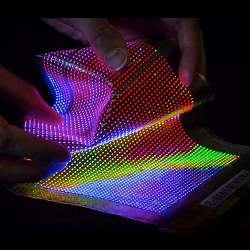
Bendable electronics, such as ribbon-cords, can be embedded with both passive and active components, making them a mainstay of automotive and computer electronics for connecting rigid printed circuit boards (PCBs). There are even bendable transistors, diodes, and other components needed to build displays and many of the low-frequency components required by cellphones. The rub, however, is that many of the most sophisticated of these components are organic, such as organic light emitting diodes (OLEDs), which provide superior color, but which require encasement in glass after they are bent, to prevent exposure to humidity and oxygen, both of which quickly degrade their performance.
Dozens of companies and research labs worldwide are researching plastic (polymer) formulations for flexible encasement, which will permit organic electronics to be bendable at will, allowing displays and the computers driving them to be unscrolled for use like blueprints.
However, for applications that do not have to be transparent, there are a variety of polymers that can not only safely encase both organic and inorganic electronic components, such as for medical implants, but which will make them not just bendable but stretchable in any direction, just like human skin. These stretchable electronics are now moving beyond the realm of expensive medical implants to consumer applications such as fabrics. In fact, Levi Strauss—the jeans maker—recently licensed stretchable fibers from North Carolina State University (NCSU). The company is mum on their possible uses for the fibers, but researchers say the fibers can be woven into clothing to create sensors that allow you to control your smartphone while it's still in your pocket.
Applications of stretchable electronics beyond medical implants and smartphone controllers include artificial skin with embedded touch (temperature and other) sensors, to replace the skin of burn victims and to give robots a sense of touch. Implantable devices in the body are also harnessing stretchable piezoelectric fibers that harvest the energy from muscle movement to generate enough electricity to eliminate the need to implant batteries that eventually will need to be replaced. The piezoelectric fibers charge stretchable supercapacitors that can hold enough energy for the implant during periods of inaction (such as when sleeping), then recharge as soon as the patient begins moving around again during the day.
These applications can take advantage of biocompatible commercial polymers that can stretch up to 900% without damage (such as Ecoflex, a product of Smooth-On Inc., Macungie, PA). Utilizing stretchable substrates to create stretchable electronics is creating a new industry sometimes called elastronics.
Applications in fashion, medicine, and robotics are just the tip of the iceberg, according to market research firm IDTechX, which has identified 32 product areas which it predicts will be responsible for a $600-million stretchable electronics market within 10 years.
The stretchable substrates are the easy part of stretchable electronics, as almost any elastomer will do—from exotic polymers (the most popular of which is a silicone called polydimethylsiloxane, or PDMS) to natural substances (such as simple rubber). All of these can sustain repeated deformation with virtually no wear and tear (compared to the lifetime of the electronics they house). Another advantage is that nearly all the stretchable substrates are dielectrics (electrical insulators), allowing channels to be etched in their interiors to hold liquid conductors as the stretchable interconnection matrix. Besides easy interconnects, the polymers encapsulate non-biocompatible components for medical implants, as well as embedding inflexible electronic components—such as microprocessors and radio-frequency (RF) communicators—that cannot be made stretchable.
The interconnection matrix among electronic components does not have to be liquid, if it does not have to carry much current. Silver and similar conductive wires, for instance, are stretchable up to 50% when fabricated at sub-micron thicknesses called nano-wires. Atomically thin monolayers of carbon (graphene) are also stretchable when deposited while the substrate is stretched, and nanometer-sized carbon-nanotube bundles not only are stretchable, but also have a resistance that allows them to act as calibrated heaters built right into the stretchable device. Conductive polymers can also act as heaters, since they harbor significant resistance compared to metals.
Instead of the few metals that are liquid at room temperature, numerous ionic liquids can also be used in channels or polymer tubing as stretchable conductors, though perhaps the most common conductive liquids injected into channels or tubes are eutectic gallium indium alloys. These alloys instantly form an oxide insulator around their length, allowing them to shrink and stretch at will while maintaining the excellent conductive properties of their cores.
If the application does not require biocompatibility, many stretchable conductive composites can be dispensed as ink from three-dimensional (3D) printers. Inflexible LEDs, for instance, can be inserted into 3D-printed structures and interconnected with such stretchable conductive composites. Organic LEDs (OLEDs) such as those used in the curved displays of some TVs and cellphones are bendable today, but are destined to become stretchable tomorrow; Apple and collaborators are creating elastomeric polymer light-emitting devices (EPLED) that can potentially become the cornerstone of a new era of stretchable displays. Even the transistors driving EPLEDs can be made stretchable by using conductive polymers, liquid-metal filled conduits, or even carbon-nanotube slurries printed onto stretchable polymer substrates. Such transistors are nowhere near as fast as silicon transistors, but for display applications they meet all the necessary requirements.
Stretchable energy harvesters (like solar cells) and batteries to store their energy are also being made stretchable using the same organic compounds used for EPLEDs. For instance, a new technology incubator at the University of California, San Diego (UCSD) called the Institute for the Global Entrepreneur—a National Science Foundation Innovation-Corps (I-Corps) program—recently demonstrated a stretchable battery printed on a t-shirt and powering an LED.
IDTechX anticipates long-lived applications we cannot imagine today will result from successful encapsulation of organic electronics with stretchable polymers, predicting they will become commonplace by 2027, resulting in a $913-million global market.
R. Colin Johnson is a Kyoto Prize Fellow who has worked as a technology journalist for two decades.



Join the Discussion (0)
Become a Member or Sign In to Post a Comment